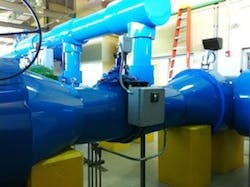The reservoir filling station at Pittsfield Township, Mich., provides water to about 39,000 people, with needs that vary from industrial and commercial to urban and rural. Their average daily water usage is 3.5 mgd, which increases up to 7.0 mgd during summer days.
The Challenge
Pittsfield has a contract with a neighboring community, Ypsilanti, to purchase up to 5,000 gpm of water that runs through its Textile Road Booster Pump Station. The station was built in 2004 and used a plug valve with an electric actuator to modulate the rate of flow into the tank, based on a meter in its system and a programmable logic controller. Ypsilanti’s water pressure is typically between 60 and 70 psi, whereas the maximum tank elevation ranges between empty and 16 ft (approximately 7 psi). Anywhere there is a high pressure drop ratio across a valve (typically a 3:1 ratio or more in pressure, where the sigma value is greater than 0.8), cavitation can be an issue. In this case, the township was well above that ratio, as 70 psi to 7 psi is much greater than 3:1, which accordingly resulted in significant cavitation of the plug valve.
The consequences of cavitation can include strong vibrations, loud noise, choked flow, erosion of valve components, destruction of the actual valve, erosion and destruction of downstream piping and, ultimately, plant or distribution system shutdown. For Pittsfield, the downstream eccentric reducer failed first, and the cavitation destroyed the cement lining in the ductile iron reducer and eventually eroded into the reducer walls. Pinholes formed, leaks sprung and the township had to replace the fitting. During the second reducer replacement, it was discovered that the cavitation damage was not reserved to the fitting—it had also begun eating into the seat of the plug valve. The township needed a solution to stop the cavitation damage immediately, as well as maintain the current valve functions with their control programming.
“After two reducers were destroyed, it was clear that the plug valve was not working in this application,” said Jennifer Zelski of Kennedy Industries. “We recommended Singer Valve’s Single Rolling Diaphragm (SRD) actuated control valve with anti-cavitation trim because it was the only plausible solution for this scenario.”
The Solution
Pittsfield Township’s engineer evaluated options with other valves and looked at closing upstream valves to help create pressure losses prior to the fill valve. All parties agreed that the SRD with anti-cavitation trim would provide the all-around solution needed to eliminate cavitation damage without sacrificing other valves or changing processes or system dynamics.
Once the actual flow ranges, inlet pressure ranges and required outlet pressure were measured, the data was given to the Singer Valve engineering team, which created a drilling pattern for the multiple orifices in the dual anti-cavitation cages, specific to this application. The key is to supply orifices that can manage maximum flow while creating enough backpressure in the cage to prevent the microscopic vapor bubbles from escaping. The dual anti-cavitation cages are then included in the new control valve.
Singer’s control valve operates hydraulically with system-line pressure, as well as with dual solenoids and an interface controller that communicates with the township’s SCADA. The SRD allows the valve to operate steadily at both high and low flows, and the pilot controls are built to be self-flushing for reduced maintenance.
Installation took three days. Most of this time was spent putting on the pipe wrap and performing some minor concrete work to modify the pipe supports under the valve. The new valve was integrated with the township controls without modification of their existing programming.
The Results
Pittsfield has a very proactive maintenance program that checks the station weekly. The strainers are always inspected, and at no point were they found to be fouled up in the first year of operation. Other than these checks, there has been no need for any maintenance.
The SRD control valve with anti-cavitation trim operates quietly and smoothly without cavitation. “The Singer Valve is working fantastically,” said Billy Weirich, Pittsfield Township utilities superintendent. “It is a simple and efficient solution with minimal maintenance.”
The valve continues to consistently modulate the flow into the tank without any shutdown, which allows the residents of Pittsfield to rely on a consistent water flow.



